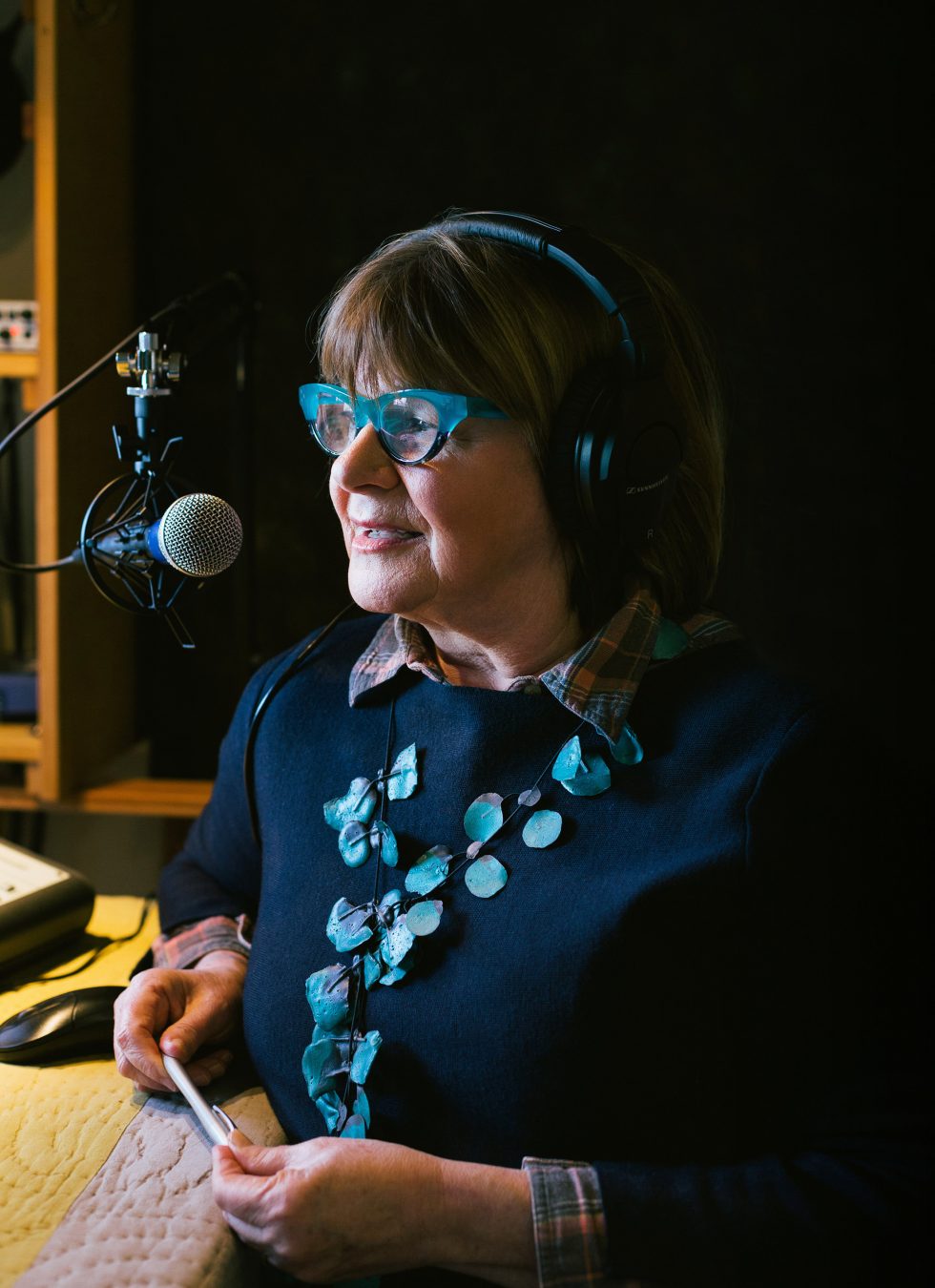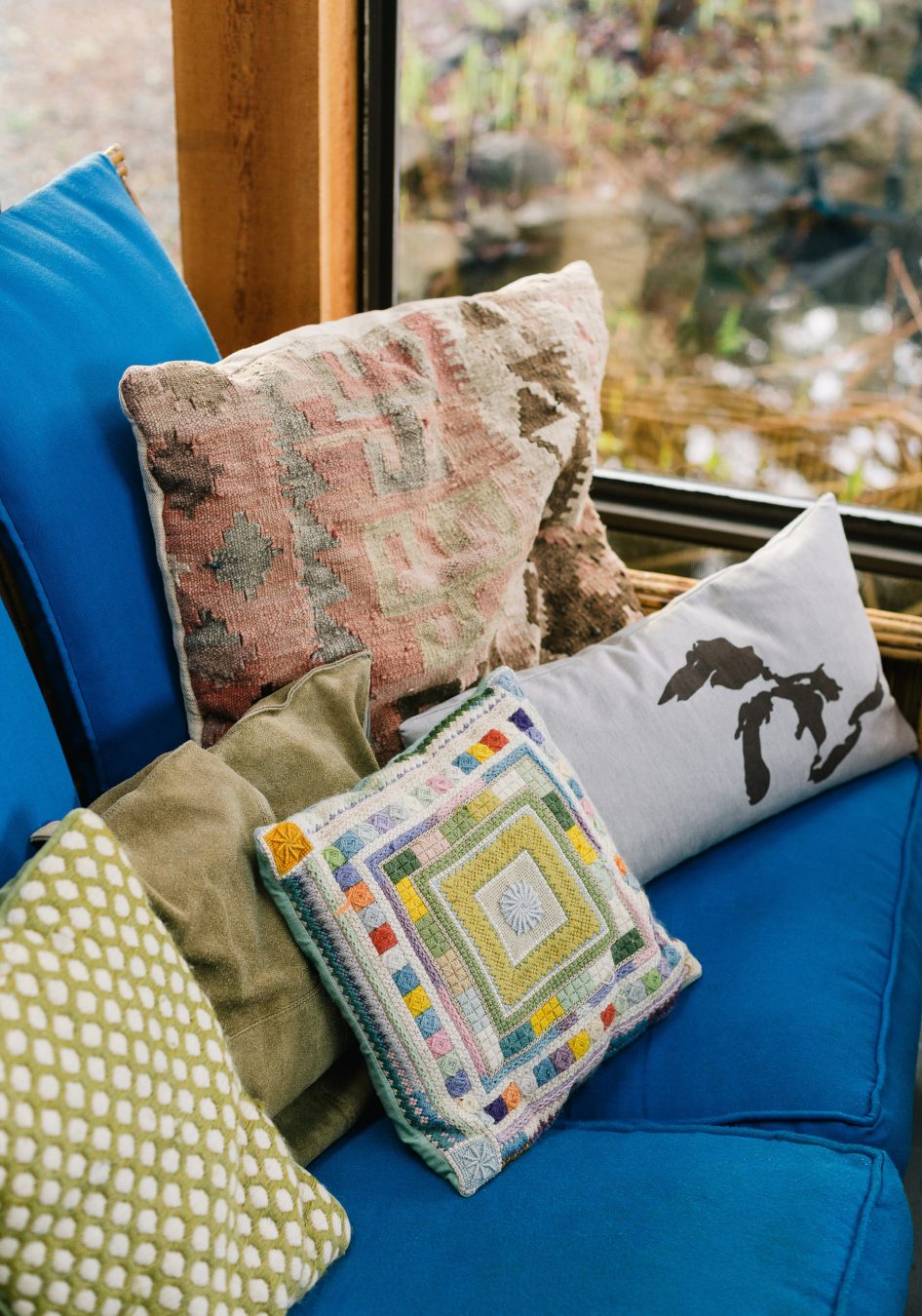Shelagh Rogers invites me into her living room just as Canadians across the country invite her into theirs when they tune into her cherished CBC Radio show, The Next Chapter. The tea is steeped, the fire is glowing, the couch is beckoning. We settle in, and her puppy, Eddie, springs onto her lap. “You are too cute,” she tells the border-terrier/dachshund cross in her signature sunny voice that sounds like everyone’s favourite aunt. “He really wants to eat the books,” she adds with a laugh.
Eddie certainly has an eclectic collection to choose from. Every week, Rogers engages in revealing conversations with Canadian writers on The Next Chapter, which is celebrating a decade on the air in 2018. Piles of books stand around the cozy Gabriola Island home the veteran broadcaster shares with her husband, Charlie Cheffins, a retired CBC senior manager. Rogers has an ability to make listeners feel like they’re eavesdropping on intimate face-to-face confabs, but most of her interviews are actually conducted over the phone (with a very good connection) from the shoebox studio Cheffins set up in their guest cabin.
Today, Rogers is in the midst of reading Forgiveness by Mark Sakamoto, one of five finalists for Canada Reads, the CBC’s annual battle of the books. It sits on her coffee table next to a library book on how to raise a puppy. A few years ago, Rogers and Cheffins had three schnauzers, all rescues like Eddie, and they recently said goodbye to the last one. Rogers was eager to adopt again; she’s been up and down with depression for decades and says she does better with a dog in her life.
It’s Blue Monday, billed as the most depressing day of the year, but the morning fog has lifted over the island of a little more than 4,000 people, and the sun is tentatively peeking through the clouds like a shy little girl behind her mother’s skirt. Rogers has been a vocal advocate for mental health since coming out with her story in 2005, an experience that has informed her other passion project: promoting truth and reconciliation between Indigenous and non-Indigenous people.
Rogers looks out the expansive window at the ocean and thinks back to her darkest days in 2003, when she was crushed by a “complete nervous breakdown” and took time off the CBC, where she’s hosted a variety of cultural and current events shows since 1980. “This is really hard for me,” she says, her steady voice faltering as she speaks about the support she received from late author Alistair MacLeod. When she was in the throes of her breakdown, he would call her from time to time even though she was unable to speak. “He would mmhmm my silence. He just made me feel like I was there.” She pauses and lifts her glasses to dab her eyes. “He taught me a really big lesson, and it’s a lesson I have to refresh myself on over and over again: listening is as important as talking, if not more so.”
Some of her friends weren’t as sympathetic, telling her to buck up or get over it. Over the years, she’s moved those people from the metaphorical top drawer of her dresser, where she keeps her underwear, to the bottom drawer, where she stores her ski pants. “That’s helped,” Rogers says. “I suggest that people do that. Don’t hang around with people who don’t believe you.”
Listen and believe. It was a mantra for Rogers as she travelled across the country from 2011 to 2015 to hear the harrowing stories of residential school survivors as an honorary witness for the Truth and Reconciliation Commission (TRC). “I really had no idea of the depth or degree of the horror that took place, or how long Canada let it go on,” Rogers admits, which is why she’s committed to sharing this shameful part of Canada’s history far and wide.
Rogers does much more than just talk about reconciliation; she takes action.
She recalls a recent visit to a Victoria middle school with Tla-o-qui-aht member Barney Williams Jr. to present the film Finding Heart, which tells the story of a medical inspector who documented the inhumane conditions at residential schools but was largely ignored. Before the screening, Williams spoke about his own experience at the Christie Residential School in Tofino and how nobody believed him. When he was done, Rogers asked the students, “Who believes Barney?” Hands flew up like a flock of birds taking flight and exclaims of “We do, we do!” echoed like a chorus. Tears stung Rogers’s eyes then as they do now.
This is just one of the stories of resilience Rogers shares over two hours, each infused with incredible details, including full names of individuals and their nations, which she articulates with care. Adding colour to these narratives, she shows me gifts she’s received along her journey, including a Stó:lō raven blanket she was wrapped in before speaking at the University of the Fraser Valley, and a glass leaf necklace a woman brought to the TRC in honour of her sister who died in a residential school; after the woman’s testimony, she handed the jewellery to Rogers, who now wears it when she speaks about her experience as an honorary witness. “It is an honour and a responsibility to carry these stories forward,” she concludes. “I am blown away by the dignity and courage of the survivors who led us out of darkness, and we really need to keep that light beaming.”
But Rogers does much more than just talk about reconciliation; she takes action. She has coedited three collections of essays by survivors and other people in civil society who have been involved in truth and reconciliation, and she has helped make real changes on the ground as chancellor of the University of Victoria—for example, she recommended to the convocation committee that they end the practice of students kneeling before her after an Indigenous student crossing the stage said his family urged him not to.
Kwagiulth and Coast Salish master carver Carey Newman (Ha-yalth-kingeme) recalls chasing down Rogers at a TRC gathering in Vancouver and asking her to participate in his reconciliation project, The Witness Blanket: a large-scale art installation that showcases hundreds of artifacts collected from residential schools and survivors. Rogers immediately said yes and provided a statement on what it means to be a witness, an image of which was transferred to the blanket. She also lent her voice to the documentary film on the project, recording voiceover for the trailer, interviewing people, and being interviewed herself by Newman.
“Shelagh does this work because it’s important to her. When she’s called to stand behind the honorary witness title, she answers. In the most lovely and gentle way, she’s willing to take on those hard questions that come from people who think that we should get over this stuff or we should be ready to move on,” Newman says, seated in the kitchen of his Victoria home. “Shelagh embodies what the word ‘ally’ means. She comes from a place of respect, kinship, friendship, and listening.”
As we walk along the ocean outside her home, Rogers reflects on how she got here and where she’s going. “I woke up,” she says, pausing along the road. “I got ‘woke.’ I feel a real urgency to make a dent in this work. If people want a better country, truth, healing, and reconciliation have got to be part of it.” Rogers might be best known for her radio voice, but it is on these issues that she speaks the loudest.
Read more from your Community.












